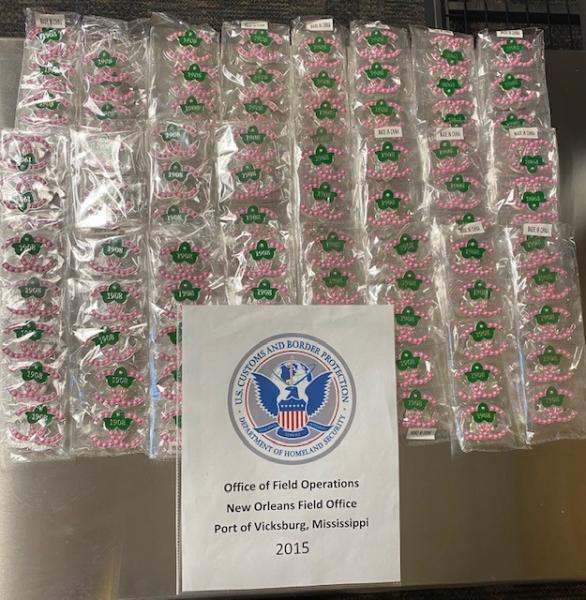Vicksburg, Mississippi — On March 29, U.S. Customs and Border Protection (CBP) Officers at the port of Vicksburg/Jackson, MS selected for inspection a shipment from China containing 250 women’s brooches. The counterfeit jewelry bore the “CC” Chanel trademark, and if genuine would be worth $162,500.00. The shipment was discovered during routine inspections at an express consignment facility located in central Mississippi.
During the 2nd quarter of fiscal year 2022, Vicksburg CBP seized a total of 73 shipments for violation of Intellectual Property Rights worth a staggering $998,889.06. Most of the shipments contained counterfeit shoes, designer handbags, jewelry, and more. During fiscal year 2021, CBP Vicksburg seized a total of 431 shipments worth over 5 million dollars. The shipments were destined to various cities throughout the central Mississippi area.
“People often make the mistake of believing that purchasing counterfeit items is a victimless crime,” said Acting Assistant Director of Field Operations Miguel Garza. “However, these items often fund transnational criminal organizations, and cost taxpayers billions.”

Illicit manufacturers continue to exploit the rapid growth of e-commerce to sell counterfeit goods to unsuspecting consumers in the United States. So far this 2021 Fiscal Year, CBP has seized more than 20,000 shipments containing counterfeit goods that would have been worth over $1.3 billion had they been genuine.
CBP data indicates that handbags, wallets, apparel, footwear, watches, jewelry, and consumer electronics are at higher risk of being counterfeited. Counterfeit watches and jewelry make up almost half of the total MSRP of seized goods. Counterfeit versions of popular brands are regularly sold in online marketplaces and flea markets. Counterfeit goods hurt the U.S. economy, cost Americans their jobs, threaten consumer health and safety, and fund criminal activity. Visit the National IPR Coordination Center for more information about IPR including counterfeiting and piracy.
In addition to posing potential health and safety hazards, counterfeit goods are often of inferior quality. Peeling labels, low-quality ink or printing errors on the packaging, and loosely packed items in the box can be signs that the product you purchased may not be legitimate. Counterfeit apparel and handbags may feature poor or uneven stitching and improperly sized or designed logos. The performance of counterfeit electronics is often marked by short battery life and regular overheating.
Consumers can take simple steps to protect themselves and their families from counterfeit goods:
- Purchase goods directly from the trademark holder or from authorized retailers.
- When shopping online, read seller reviews and check for a working U.S. phone number and an address that can be used to contact the seller.
- Review CBP’s E-Commerce Counterfeit Awareness Guide for Consumers.
- Remember that if the price of a product seems too good to be true, it probably is.
To report suspected counterfeits, visit CBP’s online e-Allegations portal or call 1-800-BE-ALERT. More information about counterfeit goods is available on CBP’s Fake Goods, Real Dangers website and StopFakes.gov.

View b-roll of CBP cargo inspections.View photos of counterfeit goods seized by CBP.


